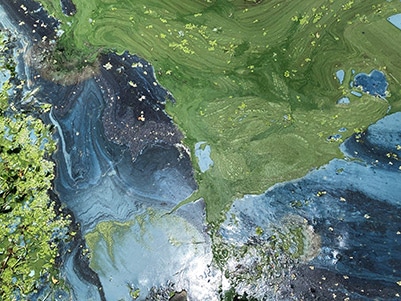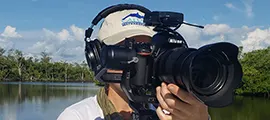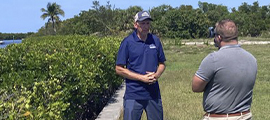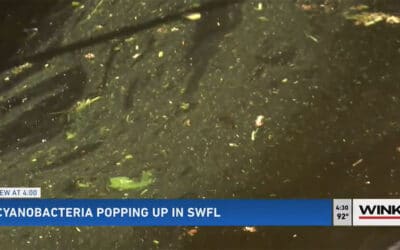Issue:
Harmful Algal Blooms

Blue-green Algae (Cyanobacteria)
Cyanobacteria is one of the oldest types of lifeforms on Earth and is found primarily in freshwater systems. There are thousands of species of cyanobacteria and many are known to produce a variety of toxins.
Cyanobacteria is a photosynthetic microorganism that processes sunlight, nitrogen and phosphorous to live. They can regualate their position in the water column for optimal light and thrive in warm, nutrient-rich fresh or brackish water with low turbulence.
Microcystis and Anabaena are two of the most common cyanobacteria found in estuarine systems today. These bacteria are known to produce cyanotoxins dangerous to humans and animals. Microcystin and Anatoxin are classes of hepatoxin and neurotoxin, affecting the liver and brain, respectively.
Human and animal exposure to Cyantoxins comes in three primary forms of contact:
- Dermal contact
- Inhalation or aspiration from aerosolized surface water
- Ingestion
Harmful algal blooms have severe impacts on human health, aquatic ecosystems and our economy.
Red Tide (Karenia brevis)
Red tide is a marine dinoflagellate found in saltwater, and has been known to inhabit the Gulf of Mexico throughout recorded history. Red tide blooms have been increasing in scope and intensity within the last 30 years. Red tide has also occurred throughout the Gulf and Atlantic Coast, reaching as far as North Carolina.
Karenia brevis can utilize at least 12 different forms of nutrients and also consume other single cell organisms for food. They are capable of motion and directed swimming allowing them greater access to nutrients.
Red Tide produces brevatoxins which can be deadly to many sea animals and often causes acute respiratory symptoms in humans. Aerosolized health effects include irritation of the eyes, nose, throat and lungs and exacerbating occurrences of respiratory distress, bronchitis, asthma and pneumonia. Brevatoxin can also have a serious impact on the marine food-chain, contributing to shellfish poisoning and gastrointestinal disorders.

Take Action
Contact Your State Legislators
Calusa Waterkeeper calls on citizens and stakeholders to urge elected officials and responsible agencies to take the following ten actions:
The toxic blue-green algae (cyanobacteria) often stretching from Lake Okeechobee to our west coast is the result of decades of failed water policy implementation. A perfect storm of lax enforcement and under-funding at the local, state and national levels has culminated in the historic harmful algae blooms (HABs) that plagued our region in 2018 (and so many other years).
If political leaders fail to take action, history is doomed to repeat itself year after year, causing catastrophic harm to our ecosystem and our economy.
The science is clear on what needs to be done.
What has been lacking is the political will to enact the regulation and legislation required to begin to reverse these problems. We look to you, as informed citizens, to proactively communicate your water quality concerns to newly elected officials. It will take a groundswell of voices if we are to affect change in Tallahassee during this coming legislative session.
Find Your Legislators
Related News Stories
Harmful Algal Blooms
Calusa Waterkeeper Looking at Effects of Blue-Green Algae Toxins
As blue-green algae blooms grow, so do health concerns. Lee County, the Department of Environmental Protection, and FGCU are all monitoring the situation as the Calusa Waterkeeper digs further into air quality testing to protect those living nearby.
Blue-Green Algae found in North Fort Myers Canal has Homeowners Feeling Uneasy
Blue-green algae have been found in a North Fort Myers canal and people are not only seeing it but smelling it as well. It blooms during this time of year, but one homeowner along the canal says in her 20 years here she has never seen it in her own backyard.
Blue-Green Algae Blooms Spotted in Multiple Cape Coral Canals
Blue-green algae has been found in at least 5 different canals in southeast Cape Coral. The Calusa Waterkeeper, John Cassani, said stormwater runoff and warmer waters are likely to blame. He advises nearby residents to do their best to stay inside and change their A/C filters.
Cape Coral sees Blue-Green Algae pop up in Multiple Canals
Blue-green algae have once again been found in Cape Coral canals. Calusa Waterkeeper John Cassani says these blooms are happening more and more. There are algae in five separate canals in Southeast Cape Coral.
Innovative Air Monitoring Device to be Presented at the Waterkeeper Alliance Global Conference in Washington
After pioneering a new monitoring device and releasing initial results, Calusa Waterkeeper board member Manuel Aparicio IV, PhD, will be presenting a workshop, “Airborne HAB Monitoring” about this ground-breaking research at the Waterkeeper Alliance Global Conference in Washington D.C.
Research Finds Airborne Toxins in Southwest Florida
There’s new information about airborne toxins in Southwest Florida as research expands. Concerns are growing about the impact on the community and the air we breathe. The Calusa Waterkeeper set up air samplers in various locations around Lee County last year after the red tide and blue-green algae outbreak in 2018.
Make a Donation
Get Notified
Priority Issues
Harmful Algal Blooms
Cyanobacteria & Red Tide
Cyanobacteria (blue-green algae) and Karenia brevis (red tide) have been making major impacts on Southwest Florida.
Lake Okeechobee Discharges
Revise System Operating Manual
The Caloosahatchee River often suffers from too much freshwater in the wet season, and not enough freshwater in the dry season.
Cape Coral Spreader Canals
Nutrient & Sediment Loading
The City of Cape Coral is working to remove large storm-water barriers to make recreational boating more convenient.
Bacteria Monitoring
Fecal Indicator Bacteria
Calusa Waterkeeper has been at the forefront of monitoring this Fort Myers tributary for fecal bacteria indicators.




































